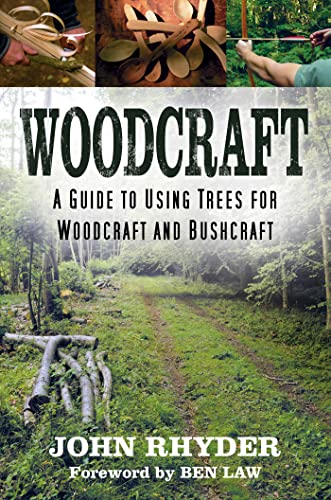From Living Woods Issue 49
SCOTT BATTY sits back and enjoys Woodcraft: A practical celebration of the tree.
Re-issued as Woodcraft: A Guide to Using Trees for Woodcraft and Bushcraft.
 WOODCRAFT
WOODCRAFT
John Rhyder
The History Press
ISBN: 978-0750998185
It’s fair to say that I have been looking
forward to the release of this book for
a long time. Having first visited John
Rhyder’s Woodcraft School in 2013
and returned for several courses since,
I realised early on that there’s much
to be learnt from Mr Rhyder. So I was
especially pleased to discover that far
from being a small and discreet offering,
this book is nearly 400 pages long and
well-illustrated throughout with colour
photographs.
‘Woodcraft’ in this book includes
bushcraft techniques as well as
woodworking, or as John says in the
introduction, ‘I explore the possibilities
that trees offer to the woodsman, and
the places where knowledge of tools
and materials can lead.’
John’s lifetime of experience in
conservation management and teaching
woodland skills shines through each
one of the nine chapters, which begin
with felling and harvesting. This is
about how the non-arborist can take
down the odd tree, perhaps for ride
management or for craft purposes, and
it is work that can be done with an axe
and saw.
Moving on to the critical area of
choosing and maintaining tools, there
is a clear run-down of the features to
consider in selecting the holy trinity
of knives, axes and saws. This chapter
concludes with an explanation of tool
sharpening which includes useful stepby-
step photos. John goes on to discuss
using tool safety, with suggestions for
effective carving techniques, grips and
projects. There’s an entire chapter on
bow-making, which walks you through
the process with plans and photos,
right through to finishing your bow,
and making your own bowstrings and
arrows. A chapter on dyes, glue and
charcoal further illuminates how to
make useful substances from natural
resources.
John’s experience in all manner of
outdoor activities seems encyclopaedic.
The section on bark, roots and withies
discusses weaving bark, making cordage
and tinder and how to make a fish
hook using roots. If you’ve not come
across withies before, they can be
used like wire or thick cord for binding
and are made from the small stems
of flexible trees (like young hazel).
The chapter on ‘Foliage, features and
fungi’ offers an introduction to tree
and fungi ID, focusing on ten common
species (ten trees, ten tree features
and ten fungi), so that the reader is not
overwhelmed.
A book of this nature would be
incomplete without a chapter on fire.
From friction (think rubbing sticks
together) to troubleshooting, it then
moves on to siting fires, as well as
discussing different fire lays – various
ways of setting up a fire to optimise it
for a particular function. Do you want
a low maintenance, fuel-efficient fire?
Or one for cooking on? This part of the
book will guide you through how best
to achieve it. Leaving no trace is also
covered, and I think this is something
many of us aspire to.
The final chapter is about ropes and
knots. You may find some of these
useful when felling a tree or when
making a bow for creating fire by
friction. Alternatively, you might just be
glad you read this review first so that
you can skip straight to Chapter 9 and
learn how to suspend your tarpaulin
and hammock safely so you can read
the rest of the book relaxing between
two trees. Lovely.
If you like spending time in woodland,
then I am confident that there is
something for you in this book –
whether you have your own small
woodland to manage or are interested
in trying some of the craft work. Far
from advocating the exploitation of
resources, it has been written with
sustainability in mind. When people are
able to engage with and take pleasure
from the natural environment, they
come to value it – and that can only
be a good thing for our trees and
woodlands.